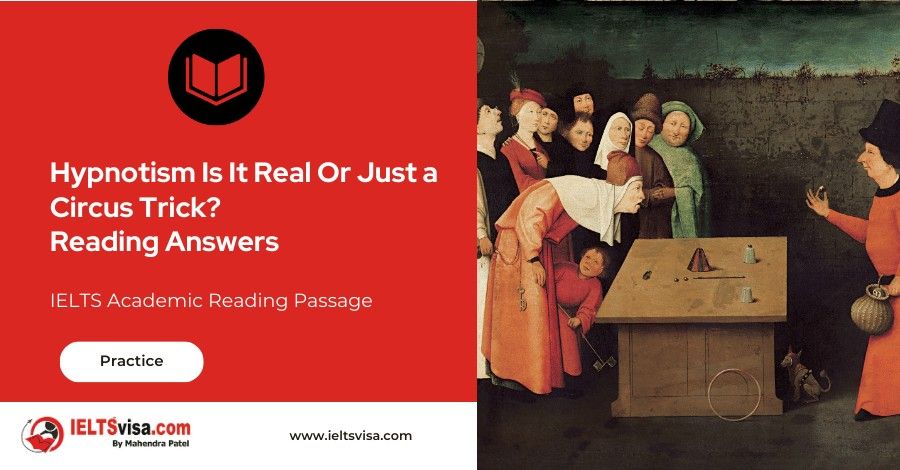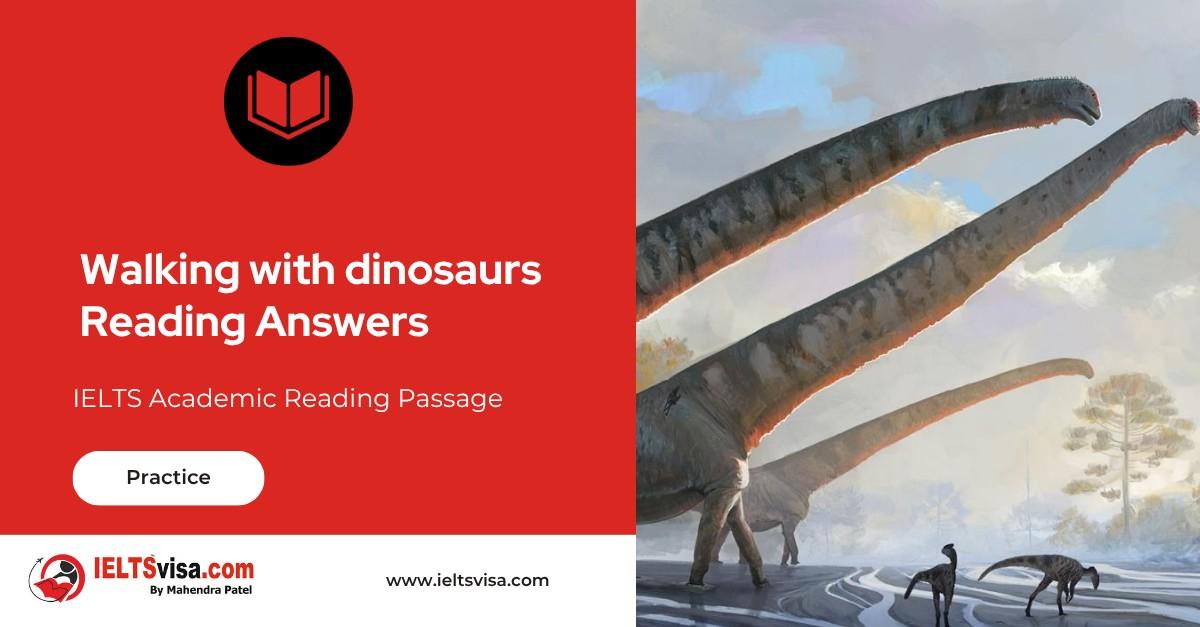Hypnotism Is It Real Or Just a Circus Trick? Reading Answers
IELTS Academic Reading Passage
A A Hypnosis has been shown through a number of rigorously controlled studies to reduce pain, control blood pressure, and even make warts go away. But because very few studies have attempted to define the actual processes involved, most scientists are sceptical of its power and uses. That scepticism has driven David Spiegel, a professor of psychiatry at Stanford University School of Medicine, USA, and other researchers to take a hard look at what happens in the brain during hypnosis.
B Along researchers there are two schools of thought. One claims that hypnosis fundamentally alters subjects’ state of mind: they enter a trance, which produces changes in brain activity. The other believes that hypnosis is simply a matter of suggestibility and relaxation. Spiegel belongs to the first school and over the years has had a debate with two scientists on the other side, Irving Kirsch, a University of Connecticut psychologist, and Stephen Kosslyn, a Harvard professor.
C Kirsch often uses hypnosis in his practice and doesn’t deny that it can be effective. ‘With hypnosis you do put people in altered states,’ he says. ‘But you don’t need a trance to do it.’ To illustrate the point, Kirsch demonstrates how a subject holding a small object on a chain can make it swing in any direction by mere suggestion, the chain responding to minute movements in the tiny muscles of the fingers.‘You don’t have to enter a trance for your subconscious and your body to act upon a suggestion,’ Kirsch says. The reaction is the result of your focusing on moving the chain in a particular direction.’
D Spiegel disagrees. One of his best known studies found that when subjects were hypnotised and given suggestions their brain wave patterns changed, indicating that they had entered a trance. In one of his studies, people under hypnosis were told their forearms were numb, then given light electrical shocks to the wrists. They didn’t flinch or respond in any way, and their brain waves resembled those of people who experienced a much weaker shock. To Kirsch this still wasn’t enough to prove the power of trance, but Stephen Kosslyn was willing to be convinced. Many external factors could have been responsible for the shift in the subjects’ state of mind, but Kosslyn wondered,‘Is there really something going on in the brain?’
E To find out, Spiegel and Kosslyn decided to collaborate on a study focusing on a part of the brain that is well understood: the circuit which has been found to process the perception of colour. Spiegel and Kosslyn wanted to see if subjects could set off the circuit by visualising colour while under hypnosis. They selected eight people for the experiment conducted at Massachusetts General Hospital. The subjects were put in a scanner and shown a slide with coloured rectangles while their brain activity was mapped. Then they were shown a black and white slide and told to imagine its having colour. Both tasks were then repeated under hypnosis.
F The results were striking. When the subjects truly saw the coloured rectangles, the circuit lit up on both sides of the brain; when they only had to imagine the colour, the circuit lit up only in the right hemisphere. Under hypnosis, however, both sides of the brain became active, just as in regular sight; imagination seemed to take on the quality of a hallucination.
G After the experiment, Kosslyn was forced to admit, Tm absolutely convinced now that hypnosis can boost what mental imagery does.’ But Kirsch remained sceptical, saying, The experiments demonstrate that people are experiencing the effects of hypnotic suggestion but don’t prove that they are entering a trance.’ He also argued that’ subjects were told to see the card in colour when they were hypnotised but only to imagine it in colour when they weren’t.‘Being told to pretend you’re having an experience is different from the suggestion to have the experience.’
H Spiegel, however, is a clinician first and a scientist second. He believes the most important thing is that doctors recognise the power of hypnosis and start to use it. Working with Elvira Lang, a radiologist at a Harvard Medical Centre, he is testing the use of hypnosis in the operating room just as he and Kossiyn did in the scanner. Spiegel and Lang took 24 patients scheduled for surgery and divided them into three groups. One group received standard care, another standard care with a sympathetic care provider and the third received standard care, a sympathetic care provider and hypnosis. Every 15 minutes the patients were asked to rate their pain and anxiety levels. They were also hooked up to painkilling medication which they could administer to themselves.
I On average, Spiegel and Lang found the hypnotised subjects used less medication, experienced less pain and felt far less anxiety than the other two groups. Original results published in The Lancet have been further supported by ongoing studies conducted by Lang.
J Spiegel’s investigations into the nature of hypnosis and its effects on the brain continue. However, if hypnosis is ever to work its way into mainstream medicine and everyday use, physicians will need to know there is solid science behind what sounds like mysticism. Only then will their reluctance to using such things as mind over matter be overcome.‘I agree that the medical use of hypnotism should be based on data rather than belief,’ says Spiegel‘, but in the end it doesn’t really matter why it works, as long as it helps our patients.’
Questions 27-31
The reading passage has ten paragraphs A-J Which paragraph contains the following information? Write the correct letter A-J in boxes 27-31 on your answer sheet.
NB You may use any letter more than once.
27. Experiment show similarity between hypnosis and vision.
28. An experiment from an opposing expert.
29. Opposing views appear due to lack of data.
30. Medical benefits makes scientific proof unimportant.
31. An experiment using people who are under medical treatment.
Questions 32-36
Choose the correct letter, A, B, C or D. Write the correct letter in boxes 32-36 on your answer sheet.
32. Kirsch uses a small object on a chain to demonstrate that
A. inducing a trance is a simple process.
B. responding to a suggestion does not require a trance.
C. muscles respond as a result of a trance.
D. it is difficult to identify a trance.
33. Spiegel disagrees with Kirsch because the subjects in Spiegel’s experiment
A. believed what they were told.
B. showed changes in brain activity.
C. responded as expected to shocks.
D. had similar reactions to control subjects.
34. Kosslyn’s response to Spiegel’s electric shock experiment was to
A. challenge the results because of external factors.
B. work with Kirsch to disprove Spiegel’s results.
C. reverse his previous position on trance.
D. accept that Spiegel’s ideas might be correct.
35. Spiegel and Kosslyn’s experiment was designed to show that hypnosis
A. affects the electrical responses of the brain.
B. could make colour appear as black and white.
C. has an effect on how shapes are perceived.
D. can enhance the subject’s imagination.
36. Kirsch thought Spiegel and Kosslyn’s results
A. were worthy of further investigation.
B. had nothing to do with hypnotic suggestion.
C. showed that the possibility of trance existed.
D. were affected by the words used in the instructions.
Questions 37-40
Do the following statements agree with the information given in Reading Passage 3?
In boxes 37-40 on your answer sheet, write
TRUE if the statement agrees with the information
FALSE if the statement contradicts the information
NOT GIVEN if there is no information on this
37. Spiegel is more interested in scientific research than medical practice.
38. Patients in the third group in Spiegel and Lang’s experiment were easily hypnotised.
39. In Spiegel and Lang’s experiment, a smaller amount of painkiller was needed by the hypnotised patients than by the other two groups.
40. Spiegel feels that doctors should use hypnotism only when it is fully understood

Solution For: Hypnotism Is It Real Or Just a Circus Trick?
Reading Answers
| 27. F | 28. C |
| 29. A | 30. J |
| 31. H | 32. B |
| 33. B | 34. D |
| 35. A | 36. D |
| 37. FALSE | 38. NOT GIVEN |
| 39. TRUE | 40. NOT GIVEN |
Review and Practice
- Regularly practice with IELTS reading samples and time yourself to get used to the pressure of the exam.
- Review your mistakes to understand where you went wrong and how to avoid similar errors in the future.
Our Books
Master IELTS Speaking Part 1
IELTS Writing Task 1 Book
IELTS Writing Task 2 Book
Hypnotism Is It Real Or Just a Circus Trick? Reading Answers Explanation
Comin Soon
Practice IELTS Other Modules
IELTS Listening
The IELTS Listening test assesses how well you can understand spoken English in various contexts. It lasts about 30 minutes and is divided into four sections with a total of 40 questions. The listening tasks become increasingly difficult as the test progresses.
IELTS Academic Reading
The IELTS Academic Reading section assesses your ability to understand and interpret a variety of texts in academic settings. It is designed to evaluate a range of reading skills, including skimming for gist, reading for main ideas, reading for detail, understanding inferences, and recognizing a writer's opinions and arguments.
IELTS Speaking
The IELTS Speaking test assesses your ability to communicate in English on everyday topics. It lasts 11-14 minutes and consists of three parts: introduction, cue card, and a discussion based on the cue card topic.
IELTS General Reading
IELTS General Reading tests your ability to understand and interpret various types of texts. Here are some key areas and types of content you can expect to encounter in the reading section, along with tips for effective preparation.
IELTS Academic Writing Task 1
In IELTS Academic Writing Task 1, you are presented with a visual representation of information, such as graphs, charts, tables, or diagrams, and you are required to summarize, compare, or explain the data in your own words.
IELTS General Writing Task 1
In IELTS General Writing Task 1, you are required to write a letter based on a given situation. The letter can be formal, semi-formal, or informal, depending on the prompt. Here’s a breakdown of the key components to include in your letter
IELTS Academic Writing Task 2
In IELTS Academic Writing Task 2, you are required to write an essay in response to a question or topic. Here’s a guide to help you understand the essential elements of this task
IELTS Exam Tips
To succeed in the IELTS exam, practice regularly, familiarize yourself with the test format, improve your vocabulary, develop time management skills, and take mock tests to build confidence.
Grammer for IELTS
Grammar is the foundation of effective communication in English. Understanding tense usage, subject-verb agreement, and sentence structure enhances clarity and coherence in writing and speaking.
Vocabulary for IELTS
Vocabulary plays a crucial role in the IELTS (International English Language Testing System) exam, especially in the Speaking and Writing sections. Here’s an overview of why vocabulary is important and how it impacts your performance
RECENT IELTS SAMPLES QUESTIONS AND ANSWERS
Walking with dinosaurs
Peter L. Falkingham and his colleagues at Manchester University are developing techniques that...
Money as the Unit of Amount Reading Answers
The most difficult aspect of money to understand is its function as a unit of account. In...
WEATHERING IN THE DESERT
In the deserts, as elsewhere, rocks at the earth's surface are changed by weathering, which...
Nature on Display in American Zoos
The first zoo in the United States opened in Philadelphia in 1874, followed by the Cincinnati...
Can We Prevent the Poles From Melting
Such is our dependence on fossil fuels, and such is the volume of carbon dioxide we have...
Air conditioning the earth reading answers
The circulation of air in the atmosphere is activated by convection, the transference of heat...













